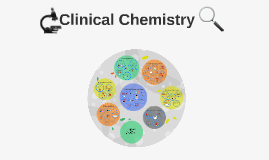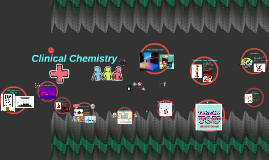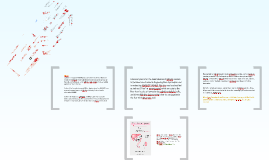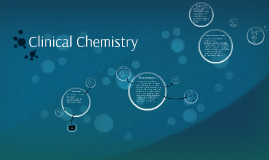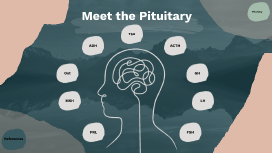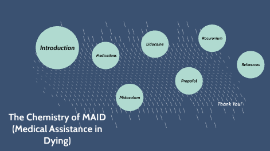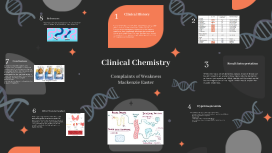Clinical Chemistry
Transcript: What is Clinical Chemistry? INtroduction its the branch of laboratory medicine that uses chemical anlaysis to study the levels of various body constituents during health and disease. These tests are usually performed on blood samples, but urine and other body fluids are analyzed Chemistry Panels/Profiles A grouping of tests that are used to reflect the state of an individuals general health OR used to evaluate a particular body system Types of specimens: Most common: blood & urine Less common: CSF, pleural, peritoneal, synovial Examples of panels Renal: glucose, BUN, creatinine, electrolytes LIPID: Triglycerides, total cholesterol, LDL, HDL Thyroid: T3, T4, TSH Cardiac: Creatine kinase Liver: Total protein, albumin, bilirubin, liver enzymrs (AST, ALT, LD, AP, GGT) Serum Proteins - formed from chains of amino acids 2 major groups: albumins (60%) and globulins (40%) Total serum protein and albumin are measured in a sample and globulin is computed from the difference (total protein - albumin = globulin) albumins serve as transport proteins globulins are comprised of antibodies, coag proteins, enzymes Albumin/globulin ratio should be 2:1; in liver and kidney disease it will be reversed; WHY? liver makes albumin, so its decreased in liver disease and in kidney disease, you lose albumin in your urine. Total serum protein provides info on state of hydration, nutrition and liver function Hypoalbuminemia occurs in liver disease, starvation, increased protein breakdown, and increased protein loss thru skin, kidneys or GI tract ELECTROLYTES refer to cations Na+, K+ and anions Cl-, HCO3- Effect hydration acid-base balance heart and muscle function MINERAL METABOLISM Calcium: bone & tooth formation; blood coagulation & neuromuscular excitation Phosphorus: bone & tooth formation Iron: Hgb production 90% is bound in calcium complexes in skeleton; only unbound is measured in lab Hypercalcemia occurs in parathyroidism, bone malignancies,hormone disorders Hypocalcemia - life threatening; due to hypoparathyroidism, vit D3 deficiency, poor Ca absorption due to intestinal disease Iron deficiency can lead to anemia; caused by iron poor diet, poor iron absorption, bleeding, impaired release of iron stores Increased serum iron levels can be due to hemolytic anemia, increased iron intake, blocked synthesis (lead posioning) Proper Kidney Function needed for water & electrolyte balance; serum & plasma creatinine, uric acid and BUN can be altered in kidney disease Creatinine is a waste product of creatine phosphate (stored in muscle for energy) If renal fucntion is impaired, serum creatinine levels increase BUN - surplus amino acids are converted to urea & excreted by kidneys Low levels: starvation, pregnancy, low-protein diet High levels: high-protein diet, after steroid use, kidney disease URIC ACID - formed from breakdown of nucleic acids & excreted by kidneys Tends to precipitate into crystals or urates Used to diagnose gout (uric acid precipitates in tissue - painful) LIVER FUNCTION Carb metabolism; produces plasma proteins; involed in lipid metabolism; source of cholesterol; storage site for vitamins, iron, glycogen; detoxifies BILIRUBIN - waste product from breakdon of Hgb; formed in liver & excreted in bile Most bili becomes bound & is called conjugated or direct; remaining is indirect Serum bili assays measure total & direct (Total - direct = indirect) Only increased levels are significant: hemolytic anemia, gall bladder disease; biliary obstruction LIVER ENZYMES - a rise typically reflects injury to liver tissue AP (alkaline phosphatase) - found thru out body, especially bone & liver ducts; increased levels w/ liver tumors & lesions ALT (alanine aminotransferase) - found in low levels in cardiac tissue and high levels in liver tissue; highly elevated in toxic and viral hepatitis AST (aspartate aminotransferase) - found in cardiac, muscle & liver tissue; elevated after MI and in liver disease GGT (gamma glutamyl transferase) - found in pancreas, kideny, liver & prostate; used to monitor recovery from hepatitis LD/LDH (lactate dehydrogenase) - throughout most of body tissue; increased after an MI and in liver disease CARDIAC FUNCTION Creatine kinase enzyme found in muscle & brain Following a heart attack, its released from heart muscle THYROID FUNCTION - thyroid gland makes hormones that stimulate metabolsim Hyperthyroidism (Graves) - excess secretion of thyroid hormones Hypothyroidism (myxedema) - decreased thyroid function T3 (triiodothyronine) - thyroid hormone T4 (thyroxine) - thyroid hormone TSH - anterior pituitary hormone that regulates thyroid gland Specimen Collection & Processing SERUM: used for most clinical chem tests Fluid that remains after blood has clottted No fibrinogen (clotting factors) in serum No anticoagulant is used in tube Gel separator; tiger or red top PLASMA: Fluid that remains after blood has not been allowed to clot Anitcoagulant is in tube Purple (heme), blue (coag tests), greent top (blood chems)






